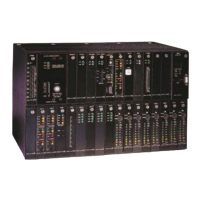Chapter 5. Diagnostics
162
T1 Alarms
The primary T1 alarms of concern to the D/I Mux III are local, remote (Yellow), Carrier Group, Frame,
Bipolar Violations, Bit 7 Zeros Suppression, 0-Density, and All Ones. These alarms are displayed on the
Line Interface Unit (LIU) front panel Light Emitting Diodes (LEDs), and in the D/I Mux III system software.
If one of these primary T1 alarms activates, an inspection of the T1 cable connections should be
conducted, and the T1 carrier company should be called.
Local Alarm
The Local Alarm (LOC) LED illuminates upon detection of a loss of T1 framing, or signal, into the
local D/I Mux III. This is often referred to as the "Red Alarm", and signifies a T1 failure. The
failure could be the fault of the carrier, a broken cable connection between the carrier interface
and the D/I Mux III, a faulty circuit card, or incorrect programming within the Dl/I Mux III system.
Yellow Alarm
The Yellow/Remote Alarm (YEL) LED illuminates if a failure is detected at the far-end T1 system.
In such an event, the remote system sends a remote "Yellow" alarm signal to the local D/I Mux III.
The received remote alarm signal also signifies a T1 failure, with potential causes as indicated
above under “Local Alarm.”
Carrier Group Alarm
The Carrier Group Alarm (CGA) LED illuminates if a T1 failure is detected, and trunk conditioning
is performed to allow circuits to be removed from operation in a controlled manner.
Frame Alarm
The Frame Alarm (FRM) LED illuminates whenever the LIUs lose synchronization (or “lock”) with
the T1 frame. A frame failure can occur because the D/I Mux III has not been programmed for
the same frame mode of operation for which the T1 span is set (ESF or D4). This type of failure
can also occur if the LIUs have lost lock with the T1 carrier because of an external failure, or a D/I
Mux III card failure.

